Consciousness Inside-Out: Wormhole UFOs, the Hill Abduction, and Interstellar
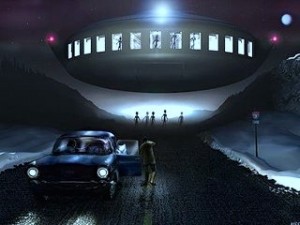
Jacques Vallee has been saying for years that our materialistic fetishism for the nuts-and-bolts secrets of UFO propulsion is a block on our imagination and a hindrance to scientific understanding of the phenomenon; there are countless other possibilities besides ‘alien spaceships propelled by antigravity.’ Thinking differently about how our visual system interprets anomalous phenomena can help illuminate some of these other possibilities. Special effects can be useful in this effort, producing breakthroughs in how we see the problem in our mind’s eye.
For example, the idea of portals and gateways is a popular one currently, yet writers mainly still operate on the mental model of aerial vessels or beings passing through these portals. But this could be missing the point. A portal itself, as shown by the intergalactic wormhole in Interstellar, would appear visually as a convex, three-dimensional object having volume, not as a “hole” or doorway. This raises the possibility that some UFOs could themselves be small wormholes generated by a machine in some advanced laboratory somewhere (or somewhen).
If this is the case, the visible exterior of a “flying saucer” might actually be the inner chamber of a wormhole-making machine.
Innies That Look Like Outies
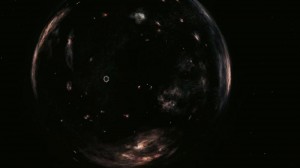 Interstellar showed how a wormhole in space would look from a distance a lot like a glass Christmas tree ornament (right). The refracted light of stars seen through and beyond it would be interpreted visually as reflected light, as off a shiny object. As you approached and lost sight of the “rim” in your peripheral vision you would see that there was actually no surface and that the convex appearance had been an optical illusion.
Interstellar showed how a wormhole in space would look from a distance a lot like a glass Christmas tree ornament (right). The refracted light of stars seen through and beyond it would be interpreted visually as reflected light, as off a shiny object. As you approached and lost sight of the “rim” in your peripheral vision you would see that there was actually no surface and that the convex appearance had been an optical illusion.
A wormhole created in the high-tech laboratory of some future “Wormhole Inc.” would look very different. It would not show stars beyond it but simply the insides of the machine or chamber generating the wormhole. Thus, it might look metallic, perhaps something like a big vacuum chamber in a physics lab turned inside-out. Visually, from a safe distance, it would appear solid and round because we would interpret its surface as convex (pushing toward us). Only as you approached it—or as it approached you—would its perspective seem to distort and your senses might finally realize you were seeing into the insides of a machine or chamber of some sort.
More likely, of course, you would be too confused, frightened, and upset by the encounter to “realize” anything at all. You would lack any precedent in your experience for such a phenomenon—or even any sci-fi special effect to relate it to.
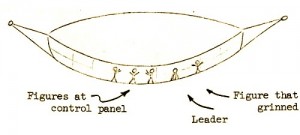 Consider the classic archetypal flying saucer or lozenge with windows around the rim, maybe with occupants looking out, as described by Betty and Barney Hill after their famous abduction (left). This seems like what a circular wormhole-creating chamber with observation windows looking into it might look like. The figures “watching out the windows” of the flying saucer could actually be proud technicians peering into their wormhole chamber.
Consider the classic archetypal flying saucer or lozenge with windows around the rim, maybe with occupants looking out, as described by Betty and Barney Hill after their famous abduction (left). This seems like what a circular wormhole-creating chamber with observation windows looking into it might look like. The figures “watching out the windows” of the flying saucer could actually be proud technicians peering into their wormhole chamber.
Wormhole Inc.
Critical ufologists like Mac Tonnies have pointed out the absurdities and inconsistencies in the Hill case—the theatrically presented star map, the not-super-high-tech (or spaceship-like) exam room, and so on. Abductees often describe interiors that are bigger on the inside than the outside or that don’t correspond well to the tightly packed and neatly arranged environment one would expect of a spacecraft. It has often been suspected that the examinations (if real) are actually taking place at an earth-bound facility somewhere, not on the “saucer.”
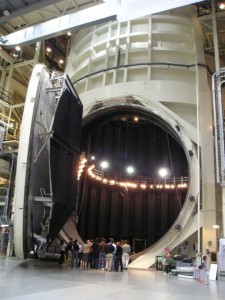 A wormhole generated in, and projected from, some large, land-based facility (e.g., on earth, in the future, or on another planet) would explain a number of things. It would eliminate the problem of packing enormous amounts of energy into a moderately sized object: If what looks like a saucer is really just the Wormhole Inc. laboratory turned inside out then it need not contain anything—no people, and no power plant.
A wormhole generated in, and projected from, some large, land-based facility (e.g., on earth, in the future, or on another planet) would explain a number of things. It would eliminate the problem of packing enormous amounts of energy into a moderately sized object: If what looks like a saucer is really just the Wormhole Inc. laboratory turned inside out then it need not contain anything—no people, and no power plant.
I am momentarily ignoring, of course, the vastly greater energy needed to create a wormhole, versus levitate a 30-foot metal disk. Current physics grants wormhole technology to Type-III civilizations capable of harnessing the energy of their whole galaxy—quite a big power plant—so my thought experiment is presuming some unforeseen technical leap or discovery making the process much more convenient.
If we do grant such a leap enabling lab-made wormholes, the theory could perhaps also help account for the laser-pointer-like motion of UFOs, which suggests they could be something insubstantial like an image being projected and stabilized in the air and not physical, massive objects actually flying. Whereas their frequent appearance on radar would make the volumetric hologram theory unlikely, a lab-made wormhole inserted into our airspace would indeed produce a radar return, albeit perhaps slightly distorted or displaced—the radar waves would simply bounce off the interior walls of the wormhole chamber and right back out. (In contrast, a space wormhole wouldn’t appear on radar because the radar waves would have nothing to bounce off of.) But the hole itself would have no mass, as the mass is all back at the lab.
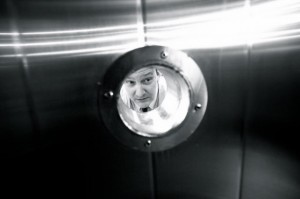 A wormhole generator also more realistically solves the more fundamental “relativistic” problem: How to bring people (e.g., relatives) to you instead of going to them—because as grown-ups realize on occasions like Thanksgiving, it’s more fun being a host than a guest. A wormhole enables you to interact with distant objects and people from the comfort of your own laboratory, not have to pack yourself into a cramped ship and go on an annoying or dangerous journey. We should bear in mind that interacting with or manipulating unwitting guests like the Hills is probably the least of a wormhole generator’s many fabulous uses.
A wormhole generator also more realistically solves the more fundamental “relativistic” problem: How to bring people (e.g., relatives) to you instead of going to them—because as grown-ups realize on occasions like Thanksgiving, it’s more fun being a host than a guest. A wormhole enables you to interact with distant objects and people from the comfort of your own laboratory, not have to pack yourself into a cramped ship and go on an annoying or dangerous journey. We should bear in mind that interacting with or manipulating unwitting guests like the Hills is probably the least of a wormhole generator’s many fabulous uses.
The World Turned Inside-Out
Beyond depicting a solution to “nuts and bolts” problems of long-distance travel, a wormhole also shows us that inside and outside are relative—one observer’s outside is another observer’s inside.
Although Interstellar was disappointing in some ways (like a clumsy script full of expository dialogue, as well as pretty lackluster spaceships), it depicted wormhole travel really well, and it also spectacularly depicted exactly the future-intervention-via-tesseract theory for paranormal phenomena that various sci-fi writers (from Madeleine L’Engle to Philip K Dick) have groped to convey in their fiction. Sometimes you need new special effects to visualize problems and produce an “aha” experience; when that happens, new solutions and new theories appear more readily.
For one thing, we are at a crux in our science and our culture when a new model is desperately needed to think about the relationship between consciousness and material reality. Much as I’m sympathetic with those who privilege consciousness against materialistic reductionism, I think a more nuanced and nonhierarchical relationship between mind and matter must be possible. A wormhole-UFO could provide such a model.
Such a beast helps us visualize, for example, how material reality is just what consciousness looks like from the outside. Matter itself isn’t the illusion, in other words—nor is consciousness. The illusion may simply be the “convex” appearance of the material world.
The word “exist” comes from the Greek eksistere, “to stand forth.” As mystics from time immemorial have insisted, the material world is a manifestation of consciousness—the self-world continuum experienced passively, as observed, rather than actively, as observing. These two aspects pass from one to the other at certain mysterious boundaries—in dreams, at death, and in paranormal phenomena (such as UFOs) that turn our outside into an inside (or vice versa) without our quite being aware how we made the passage.






Eric, your speculations here are bang on and echo some of my own–I have a PDF of an article around here _somewhere_ that explains a wormhole would appear lenticular, just as you propose. I hope you get the opportunity to share your thoughts in an even wider forum!